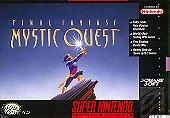Most Final Fantasy games have the same formula, but Mystic Quest mixed it up a little; it was a pretty gutsy move for 1992 and a company that didn't have many games out yet.
Good Features
The monsters are visible and can easily be avoided, so you don't face random battles. You are able to real-time weapon change, which means that you can switch between all of your weapons by pressing L or R, and use them to affect the surrounding environment (chop down trees, blow up rocks, etc.). Your armor is accumulated as a whole and automatically equipped. Every direction you can go is displayed on the world map, meaning you don't spend all that time mucking about trying to find your way to your next destination. It is also an over-the-shoulder type of battle, so you won't be on the right of the screen with your enemies on the left. You'll have battle tournaments of ten rounds each where you can win prizes for defeating everything. And lastly, you can jump, which opens up different pathways and possibilities.
Bad/Cheap Features
When you find a treasure chest, you can go back to the world map, re-enter, and the treasure chest will be full again - I find this to be a bad thing, whereas some people might find it to be a good thing because it negates the need for Item Shops. When you die, you are asked if you wish to restart the battle, minus anything you might have used before - you'll fight the same monsters, minus the 5 arrows you used against them the first time. You have several different magic levels, and you are alotted a set number of casts per level; once you get Life, for instance, you'll be able to cast any White Magic 30 or so times, and once those are used up you'll have to rest to regain them (no pesky MP ratings). Also, you can only have one other person in your party besides Benjamin, which limits your success at taking down powerful enemies.
The storyline is the usual fare from Final Fantasy games - you must save the world from an evil being by unleashing the power of four crystals, and various people help you along the way. However, you don't get to choose who is in your party! Friends like Kaeli and Tristam join your party in exchange for your services to help them, and they leave whenever they want. One of the gripes I have about this is how, towards the end of the game, one of your friends rejoins your party, but he is still at the same level - naturally, he dies every battle.
The graphics are your average 16-bit sprites that were common in all RPGs during this timeframe, so I'm not going to penalize them by comparing them to graphics today.
The sound is awesome. It was composed by Ryuji Sasai and Yasuhiro Kawakami, not by Nobuo Uematsu, and the heavy rock and roll influences are noticeable. The "Victory Fanfare" theme in this game is the absolute best rendition I have ever heard, and one of the other songs is a rendition of "Johnny B. Goode" by Chuck Berry.
There is virtually zero replayability, unless you find it necessary to look for hidden items or level up to 99, which isn't necessary to complete the game. Again, I'm not going to penalize the game for this because other games in that era also lacked "New Game +" features.
If you are looking for something different from the typical RPG, this is a great game for you. I was very impressed with it.
8/10
 Login
Login